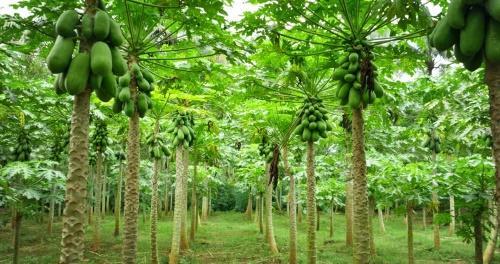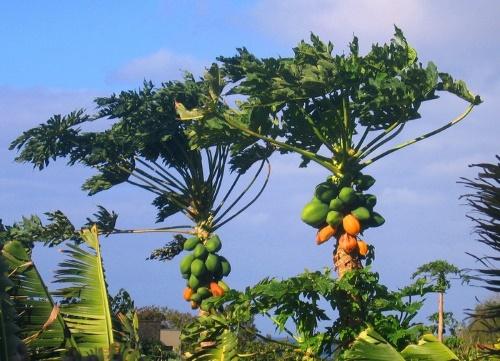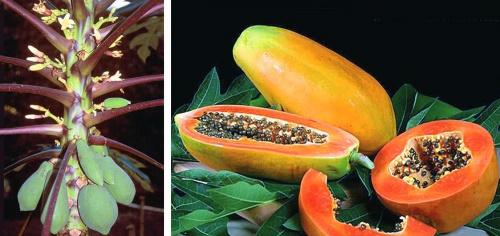Where does the melon tree grow - get acquainted with an exotic plant
 Those who have seen pear-shaped fruits on the supermarket at least once have probably wondered where the melon tree grows. After all, this is precisely his harvest, and in our area such a wonder can not be seen anywhere else. It is not surprising, because a wonderful tree is not suitable for our climate due to its exotic origin. What is it, why is it called that and where do its delicious fruits come from?
Those who have seen pear-shaped fruits on the supermarket at least once have probably wondered where the melon tree grows. After all, this is precisely his harvest, and in our area such a wonder can not be seen anywhere else. It is not surprising, because a wonderful tree is not suitable for our climate due to its exotic origin. What is it, why is it called that and where do its delicious fruits come from?
The melon tree is nothing more than the papaya we know.
What is culture

 The large fruits of the melon tree, which are called fruits in our market, are actually berries. Since such a tree has no branches, they are tied directly on the trunk, under a leafy rosette, turning it into a kind of stuffed rocking chair. The upper part of the berries can be located between the petioles of the lower leaves. Green papayas are tasteless and hard, but when ripe they resemble our melon and even surpass it. The pulp becomes soft, juicy and sweet, but slightly sour. The green peel turns into a rich melon-yellow color. In the context, papaya is also similar to a melon and has black seeds inside.
The large fruits of the melon tree, which are called fruits in our market, are actually berries. Since such a tree has no branches, they are tied directly on the trunk, under a leafy rosette, turning it into a kind of stuffed rocking chair. The upper part of the berries can be located between the petioles of the lower leaves. Green papayas are tasteless and hard, but when ripe they resemble our melon and even surpass it. The pulp becomes soft, juicy and sweet, but slightly sour. The green peel turns into a rich melon-yellow color. In the context, papaya is also similar to a melon and has black seeds inside.
The seeds are distinguished by their high germination capacity and a burning peppery taste.
Where does the melon tree grow
Papaya is a true tropicana, therefore it grows only in warm and humid tropical and subtropical climates. Under natural conditions, the tree-grass can be found in Central America, Mexico, India, Cuba. The plant also took root in hot Africa.
Can papaya be grown in the local climate?
 Given the thermophilicity of the melon tree, it will not survive outdoors in our climate. But he feels good in greenhouses or just in a tub in a house or apartment. The easiest way to get exotic is to buy a ripe berry, choose seeds from it and plant it. Moreover, this is one of the earliest ripening crops: it begins to bear fruit in the first year of life.
Given the thermophilicity of the melon tree, it will not survive outdoors in our climate. But he feels good in greenhouses or just in a tub in a house or apartment. The easiest way to get exotic is to buy a ripe berry, choose seeds from it and plant it. Moreover, this is one of the earliest ripening crops: it begins to bear fruit in the first year of life.
To grow papaya at home, you need to take into account the specific requirements of this crop:
- First of all, she needs large dishes, despite the superficial location of the root system.
- The soil for the tree should be loose and nutritious. Suitable substrate for ficuses.
- The presence of a drainage layer in the pot is a must, since papaya will not tolerate stagnant moisture.
- It is necessary to water the tree often, but in small portions.
- To get a large crop, you need to provide good lighting.
- In the summer, it is better to take the pot out into the garden, but in the fall you should definitely take the tree indoors.It won't survive the winter outdoors.
- From spring to early autumn, you need to feed the plant, alternating organic matter and mineral complexes.